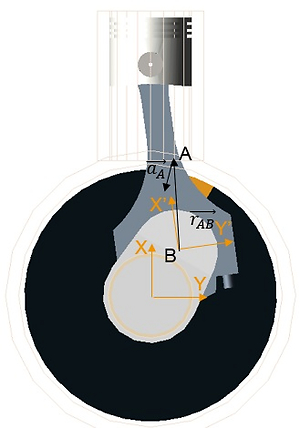Current issue
Online first
Archive
About the Journal
Aims and scope
Publisher and Editorial
Advertising policy
For Authors
Paper review procedures
Procedures protecting authentic authorship of papers
Paper preparation manual
Plagiarism check
Publication ethics
Reviewers
APC
Editorial and Scientific Board
Contact
Reviewers
Simulation of the oil supply through the connecting rod to the piston cooling channels in medium speed engines
1
FEV Polska Sp. z o.o.
Submission date: 2019-09-03
Final revision date: 2019-10-15
Acceptance date: 2020-01-04
Publication date: 2020-03-30
Combustion Engines 2020,180(1), 25-30
KEYWORDS
TOPICS
ABSTRACT
The importance of the oil flow simulation in connecting rod oil channels during the engine development process is recently increasing. This can be observed either in medium speed engines, where, as one of the traditional solutions, the oil for piston cooling is supplied through the connecting rod, or in automotive engine VCR (variable compression ratio) connecting rods, where engine oil is used to change the compression ratio of the engine. In both cases, precise numerical results are necessary to shorten the prototyping period and to reduce the overall development cost.
The multi-physics character of the simulation problem basically consists of the interaction between the dynamics of the crank train components and the oil flow. For the oil supply to the piston cooling channels through the connecting rod in medium speed engines, being the objective of this paper, a major influencing factor is the oil pressure behavior in the piston cooling gallery providing periodical interaction with its supply. At the same time, the connecting rod elastic deformation during engine operation can be regarded as negligible and the planar motion of the connecting rod can be reproduced by combination of translational and rotational acceleration fields in the CFD solver.
The paper includes the description of the applied simulation approach, the results and a comparison with the state-of-the art calculation without consideration of the above-mentioned influencing factors.
ACKNOWLEDGEMENTS
Authors would like to thank M.Sc. Eng. Ladislav Kali-na, MSc. Eng. Piotr Sułkowski (FEV Polska Sp. z o.o.), Dr.-Ing. Sven Lauer, Dr.-Ing. Carl Ritterskamp and Dipl.-Ing. Ralf Rauschen (FEV Europe GmbH) for their support and contribution in the development of the simulation ap-proach presented in this paper.
REFERENCES (4)
1.
PENDOWSKI, D. Numerical methods to investigate the dynamic behavior of a VCR conrod. FEV Simulation and Calibration Day. Stuttgart 2018.
2.
JĘDRZEJOWSKI, J. Mechanika układów korbowych silników samochodowych, WKiŁ. Warszawa 1986.
3.
MAASS, H., KLIER, H. Die Verbrennungskraftmaschine, Band 2: Kräfte, Momente und deren Ausgleich in der Verbrennungskraftmaschine. Springer. 1981.
CITATIONS (6):
1.
World-wide trends in powertrain system development in light of emissions
legislation, fuels, lubricants, and test methods
Piotr BIELACZYC, Joseph WOODBURN, Ameya JOSHI
Combustion Engines
Piotr BIELACZYC, Joseph WOODBURN, Ameya JOSHI
Combustion Engines
2.
Mechanisms of enhanced heat transfer of piston oscillating cooling in a heavy-duty diesel engine
Zhaowen Wang, Junyu Lu, Peng Deng, Shengping Li, Kaida Wang, Chi Zhang, Xiaobei Cheng, Jie Zhang, Yuhan Huang
Applied Thermal Engineering
Zhaowen Wang, Junyu Lu, Peng Deng, Shengping Li, Kaida Wang, Chi Zhang, Xiaobei Cheng, Jie Zhang, Yuhan Huang
Applied Thermal Engineering
3.
Analysis of the tribological behaviour of the lubricated contacts of a connecting rod equipped with a direct pin oiling gallery
Valerio Mangeruga, Saverio Giulio Barbieri, Matteo Giacopini, Luigi Bianco, Andrea Ferretti, Michele Mazziotta
Tribology International
Valerio Mangeruga, Saverio Giulio Barbieri, Matteo Giacopini, Luigi Bianco, Andrea Ferretti, Michele Mazziotta
Tribology International
4.
Study on cooling category and heat transfer mechanisms of piston oscillating cooling in a dual gallery structure
Junyu Lu, Xing Wu, Zhaowen Wang, Chi Zhang, Qingwen Zeng, Chunhui Wang, Wuqi Wen
Applied Thermal Engineering
Junyu Lu, Xing Wu, Zhaowen Wang, Chi Zhang, Qingwen Zeng, Chunhui Wang, Wuqi Wen
Applied Thermal Engineering
5.
A numerical simulation study of fluid-solid-thermal bidirectional coupling in an aviation kerosene engine piston and piston cooling gallery based on experiments
Guisheng Chen, Yuxin Liang, Yuchen Xu, Yuanzhi Xu, Renxin Xiao, Songjun Wu, Xinrui Wang
International Journal of Engine Research
Guisheng Chen, Yuxin Liang, Yuchen Xu, Yuanzhi Xu, Renxin Xiao, Songjun Wu, Xinrui Wang
International Journal of Engine Research
6.
Optimization of the cooling system in a prototype VCR engine using CFD analysis
Mirosław Jakubowski
Combustion Engines
Mirosław Jakubowski
Combustion Engines
We process personal data collected when visiting the website. The function of obtaining information about users and their behavior is carried out by voluntarily entered information in forms and saving cookies in end devices. Data, including cookies, are used to provide services, improve the user experience and to analyze the traffic in accordance with the Privacy policy. Data are also collected and processed by Google Analytics tool (more).
You can change cookies settings in your browser. Restricted use of cookies in the browser configuration may affect some functionalities of the website.
You can change cookies settings in your browser. Restricted use of cookies in the browser configuration may affect some functionalities of the website.



